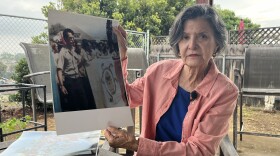





Syrian kids who passed through Milan's Central Station last year did something very Italian: create artwork. While they waited for trains to take them to northern Europe, Save the Children offered them a chance to draw. They could depict whatever they wanted, says psychologist Vittoria Ardino, president of the Italian Society for the Study of Traumatic Stress, who analyzed 500 of these images.
There's a lot that can be learned from children's art. "It's one of the most effective tools to help them be understood by adults," Ardino says. Even if children are not yet able to express their emotions in words, they can put those feelings into figures and shapes. Their pictures reveal how they see themselves and their connections with others, Ardino adds.
Given the circumstances, perhaps it's not so surprising that, as Ardino notes, "most of the drawings are related to war and the journey to escape conflict." But beyond the distress, she detects resilience. "There's still some hope in these children," she says.
We asked her to reflect on seven of the drawings.
There's so much happening on this piece of paper — which is maybe a reflection of the child's chaotic inner world, Ardino says. A flying creature is part butterfly, a common symbol of freedom. But it's also part gun. A plane dropping bombs is covered by a face that's half-human and half-fish (or actually, a big fish devouring a smaller one). A flower droops over a series of squiggles, which Ardino believes represent human bodies. All of that points to a child feeling powerless — but "trying desperately to find light," Ardino adds. The face is surrounded by sun, and an oversized ladder or staircase leads away from the houses. Ardino suggests this is the child's attempt at answering a critical question: "How can I escape?"
Although Save the Children didn't record the age of the kids, Ardino suspects that this image was drawn by an older boy or girl — certainly older than 5 or 6. The side-by-side benches are immediately recognizable, she says: "That's the place at the Milan station where they sat." She sees the hearts lined up next to the family as a metaphor for loved ones the child lost along the way to the station. Despite that, the drawing feels more uplifting than somber because of the bright sun above. To Ardino, it's a sign that this child dreams of a better future.
The sea voyage labeled "journey of death" isn't subtle. "This is a photograph of what is happening," Ardino says. "Many people are literally stuffed in the bottom of a boat." The passengers shouting "help" (in English and Italian) are a reminder that children who've been through this experience need counseling. Probably their parents do, too, Ardino adds.
Looking into this eye, Ardino sees Syria crying. She thinks this is likely the work of an adolescent. Among kids who seemed to be older, political imagery was quite popular. Many drew flags, for instance.
Faces and human figures were common in the drawings, but few were as striking as this image, which reminds Ardino of Edvard Munch's famed "The Scream." The details — like the flames inside the eyes — reveal a mix of fear, horror and anger. And the pair of brown horns that indicate this is the devil "tell us a fuller story," Ardino says. Like many of the other faces in the children's drawings, this one is floating, removed from any background. She says that's another sign that the kids don't feel safe where they are.
"If you hadn't known this was drawn by a Syrian kid, you'd think nothing happened," Ardino says. It's the typical childhood drawing of a house surrounded by a tree and grass and flowers. In the background are fluffy clouds, rolling hills and a bright orange sun. There's a figure walking a dog near a body of water. To Ardino, this is an expression of nostalgia. Her interpretation of what this kid is saying is, "I want things as they were."
In this self-portrait, what stands out to Ardino is the face. "You can see the black points under the eyes. I think the child is crying," she says. But the mouth looks like it's smiling — maybe because of the message beside the boy: "I want to live happy with my family." This confusion is a reminder of how difficult it is to express emotions, particularly when they are as complex as those experienced by child refugees.
Copyright 2016 NPR. To see more, visit http://www.npr.org/.






